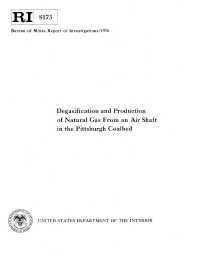Mining Publication: Degasification and Production of Natural Gas From an Air Shaft in the Pittsburgh Coalbed
Original creation date: January 1976
The Bureau of Mines conducted research to determine the effectiveness of long holes drilled in solid virgin coal in degasifying an area of the Pittsburgh coalbed showing that horizontal holes drilled into a virgin coalbed from the bottom of any shaft will effectively remove methane gas in commercial quantities from the Pittsburgh coalbed. The in situ pressure at a depth of 214 feet into the coalbed and the average gas and water flows from the five degasification holes were 3 lb/in2 gage and 860,000 ft3/d and 1.7 Gal/min, respectively. On June 19, 1975, after 593 days of degasification, a compressor was installed and pipeline quality gas was introduced into a commercial pipeline. As of June 1, 1976, after 1,022 days of degasification, over 753 million cubic feet of gas had been drained and 117 million cubic feet of gas had been purchased by the gas company for use in the local community of Wadestown, West Virginia. The gas drained to date is six times the gas estimated to be in the area subtended by the holes. Methane emissions at the working face of 1 west mains, Federal No. 2 Mine has been reduced by 50 pct, proving the value of methane drainage by horizontal degasification holes drilled from shaft bottoms ahead of mining.
Authors: HH Fields, J Cervik, TW Goodman
Report of Investigations - January 1976
NIOSHTIC2 Number: 10000669
Pittsburgh, PA: U.S. Department of the Interior, Bureau of Mines, RI 8173, 1976 Jan; :1-23
See Also
- Advances in Grid-Based Numerical Modeling Techniques for Improving Gas Management in Coal Mines
- A CART Technique to Adjust Production from Longwall Coal Operations under Ventilation Constraints
- Coal Mine Methane: A Review of Capture and Utilization Practices with Benefits to Mining Safety and to Greenhouse Gas Reduction
- Directional Drilling For Coalbed Degasification: Program Goals and Progress in 1978
- Directionally Controlled Drilling To Horizontally Intercept Selected Strata, Upper Freeport Coalbed, Greene County, Pa.
- Historical Development of Technologies for Controlling Methane in Underground Coal Mines
- Methane Control by Isolation of a Major Coal Panel - Pittsburgh Coalbed
- Removing Methane (Degasification) from the Pittsburgh Coalbed in Northern West Virginia
- Rotary Drilling Holes in Coalbeds for Degasification
- Rotary Drilling Techniques Used in the Beckley Coalbed
- Content source: National Institute for Occupational Safety and Health, Mining Program


 ShareCompartir
ShareCompartir
